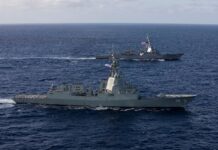By Robert H. Reid
U.S. sailors in the Persian Gulf can expect increased harassment by Iranian vessels as Iran’s hard-liners seek to bolster their position ahead of next year’s Iranian election and the U.S. is absorbed in its own electoral campaign.
Some analysts also believe the three incidents Tuesday and Wednesday, during which Iranian fast boats swarmed around U.S. warships in the northern Gulf and the Strait of Hormuz in the southern end, were to practice “swarm tactics” for attacking larger and better armed American vessels. In one of the incidents, the USS Squall, a coastal patrol ship, fired shots in the water to warn the Iranians. The latest incidents serve as a reminder that tensions remain high between the United States and Iran despite last year’s international agreement to curb Iran’s nuclear program and lift crippling international sanctions.
Fox News quoted U.S. officials as saying there had been at least 30 dangerous interactions with the Iranians in the Gulf as of Friday – about the same number as in all of 2015. Last December Iranian ships fired rockets near U.S. warships in the Strait of Hormuz and flew an unarmed drone over the aircraft carrier the USS Harry Truman. The following month Iran briefly detained 10 U.S. Navy sailors and forced them to kneel for propaganda pictures after they strayed into Iranian waters.
All this led Adm. John Richardson, Chief of Naval Operations, to ponder whether the U.S. was facing a tense “new normal” in the Persian Gulf. “We have to be mindful that we don’t become complacent as things get steadily busier, steadily more engaging and that we’re thoughtful about how we approach those challenges,” Richardson told reporters after the most recent incidents. U.S. officials have not speculated publicly about Iran’s possible motives, pointing out that such harassment has been common in the Gulf for decades. According to the Navy about 10 percent of its encounters with Iranian ships since the beginning of 2015 have been “unsafe and unprofessional.”
The Iranians themselves brushed aside U.S. criticism, saying Tehran reserves the right to investigate the intentions of any vessel operating close to its shores. Two conservative Middle East defense analysts, Stephen Bryen and his wife Shoshana Bryen, believe the latest incidents were actually tests of new “swarming boat tactics” for engaging U.S. warships.
Writing in the U.S. News and World Report website, the Bryens said the tactics involve a number of fast boats armed with missiles and torpedoes attacking enemy ships from multiple directions. “Recently, the Iranians added another dimension to the swarming boats: a vessel known as the Ya Mahdi, a remotely piloted fast patrol boat that can fire rockets or be stuffed with explosives,” they wrote. The fast boats are manoeuvrable and can operate at up to 75 knots, they wrote. Some are built mostly with Fiberglas, which makes them difficult to detect with radar.
Whatever Tehran’s recent intentions, Iran’s behaviour in the Gulf is often determined by internal Iranian politics, which can be confusing and opaque. That often leads to actions which appear at odds with public statements by factions within the leadership that pursue agendas different from the hard-line Revolutionary Guard, whose naval units carried out the latest incidents. “In particular, the provocations may have a domestic political dimension aimed at those within President Hassan Rouhani’s government who advocate better relations with the West,” wrote Farzin Nadimi, a U.S.-based analyst writing in the website
The Washington Institute, a private think tank. Nadimi wrote that the Revolutionary Guard may be trying to bolster their image as the protector of Iran’s coastal borders to justify their substantial share of the defense and research budget. Some analysts also believe the hard-liners could be manoeuvring for a political comeback in next May’s presidential election. Rouhani was elected in 2013 on a pledge to end Iran’s international isolation and reverse the economic decline brought about by international sanctions and mismanagement by his hard-line predecessor, Mahmoud Ahmadinejad. Rouhani’s allies also won important gains in parliament at the expense of the hard-liners in April’s legislative election.
Rouhani has not announced whether he will seek a second term. But some of his policies have come under fire from the real power in Iran, Supreme Leader Ayatollah Ali Khamenei, who is close to the Revolutionary Guard and openly hostile to the U.S. Khamenei has said that the nuclear deal with the West and subsequent lifting of international sanctions, the signature achievement of the Rouhani administration, has failed to benefit ordinary Iranians. A major incident with the U.S., which Iran’s state-controlled media would blame on the Americans, could bolster the hard-liners and portray Rouhani’s policies as a failure. “In the meantime, observers should not be surprised if the naval harassment continues in the coming weeks,” Nadimi wrote. “Washington should, therefore’ be especially vigilant… All this comes at a time when the Obama administration is in its final months.
The new U.S. president will be chosen in November, but it will take months afterward before the new chief executive’s team is fully in place. “The Persian Gulf is the Iranian nation’s home,” Khamenei said in a speech last May. “We must be present in that region, hold war games and demonstrate power. … It is the Americans who should explain why they have come here from the other side of the world and stage war games.
Source : Stars & Stripes



